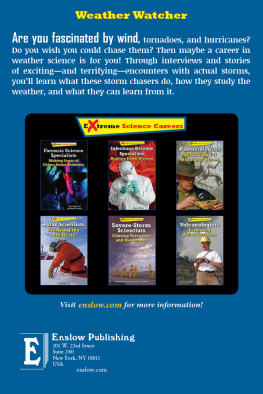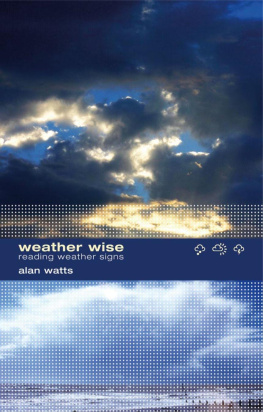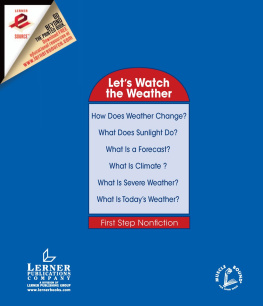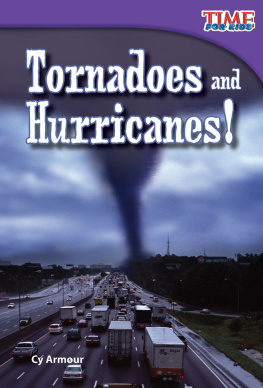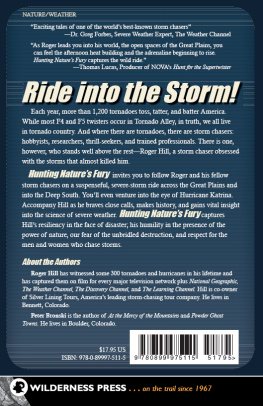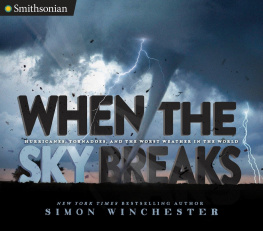Published in 2016 by Enslow Publishing, LLC
101 W. 23rd Street, Suite 240, New York, NY 10011
Copyright 2016 by Enslow Publishing, LLC
All rights reserved.
No part of this book may be reproduced by any means without the written permission of the publisher.
Library of Congress Cataloging-in-Publication Data
Way, Jennifer, author.
Severe-storm scientists : chasing tornadoes and hurricanes / Jennifer Way and Timothy R. Gaffney.
pages cm. (Extreme science careers)
Summary: Discusses careers in storm science, including education, training, specialties, and salaries Provided by publisher.
Audience: Ages 12+
Audience: Grades 7 to 8.
Includes bibliographical references and index.
ISBN 978-0-7660-6968-8
1. Severe stormsJuvenile literature. 2. Storm chasersJuvenile literature. 3. MeteorologyJuvenile literature.
I. Gaffney, Timothy R., author. II. Title.
QC941.3.W39 2016
551.55dc23
2015011327
Printed in the United States of America
To Our Readers: We have done our best to make sure all Web site addresses in this book were active and appropriate when we went to press. However, the author and the publisher have no control over and assume no liability for the material available on those Web sites or on any Web sites they may link to. Any comments or suggestions can be sent by e-mail to .
Portions of this book originally appeared in the book Storm Scientist: Careers Chasing Severe Weather.
Photo Credits: All Canada Photos/Alamy, p..
Cover Credits: Jim Reed/Science Source (launching weather balloon).
Contents
Chasing Knowledge
Natures Fury
A Storm Lab in the Mountains
Alaskas Wild Weather
Into the Eye of a Hurricane
Unlocking Lightnings Mysteries
Climate Clues in Sea Ice
Appendix: Severe-Storm Scientists: Jobs at a Glance
Chapter Notes
Glossary
Further Reading
Index
Chasing storms is an exciting and, at times, dangerous job. The men and women who follow severe storms put in a great deal of work and preparation to ensure their safety.
Chapter 1
Chasing Knowledge
O n May 29, 2004, an intense storm swept across western Oklahoma. Wind kicked up the dust, while rain beat it back down. Although no human eye could see it yet, a tornado was forming. Dr. Joshua Wurman had an electronic eye trained on the storm, using a special radar unit that was mounted on the back of a truck.
Joshua Wurman is a scientist who hunts tornadoes. His mobile radar unit is a special tool he made to help him hunt them. The radar unit emits radio signals and measures the echoes that bounce back. It can measure wind speeds and directions inside a storm, including the mysterious, whirling funnel of a twister. It even lets him study what is happening inside a tornado, the way a doctor might use x-rays to peer inside a patients body.
This storm was a brute. It was a storm [that] was very windy and kicking up a lot of dust, Wurman recalls. We couldnt see. We had several vehicles in our fleet, and we told everybody to stay away, and we went into the storm... with the radar.
By 2004 Wurman had seen and studied tornadoes and violent storms more closely than most scientists. But violent storms could still spring surprises. This one was about to.
We parked [the truck] in front of the tornado, about two to three miles [3-5 km] away, and started scanning it [with the radar unit]. Thats the usual thing we do. Wed get in front of it and let it come towards us, and at a certain time when it got too close, we would run away.... The tornado got less than a mile from us, so we said, All right, time to move.
Wurman was sealed inside a tiny cabin between the radar and the drivers cab. He was concentrating on the radar data that flowed across a computer screen. But he could tell something was wrong outside.
Were driving south, and its clear were not moving on the highway. Im yelling at my driver in front, saying, We cant stop here. Weve got to keep moving. Theres a tornado coming at us. And hes yelling back at me, telling me he had the [gas pedal] floored, and we werent going anywhere.
The tornado came right at them. Thanks to the radar, Wurman could see it: a tight funnel of wind whirling at 130 miles (209 km) an hour. But the radar was detecting an additional threat that only later study would make clear: the truck couldnt move because the storm surrounding the tornado was packing winds of up to 180 miles (290 km) an hour!
A homeowner sifts through the remains of his property in El Reno, Oklahoma. A series of tornadoes devastated the area on June 1, 2013.
The door got ripped off our truck. Stuff got ripped off the roof. It was getting bad quickly, and we couldnt figure it out, and we couldnt get out of it because we couldnt move the truck.
Scientists who study weather have many high-tech tools and gadgets at their disposal. Space satellites observe weather from above the atmosphere. Instruments at remote stations around the world tirelessly report weather conditions. Supercomputers crunch massive amounts of data that can help predict the weather and track changes in Earths climate.
Torandoes near Oklahoma City were responsible for overturning cars and causing damage to homes and businesses.
The 2013 tornadoes of El Reno, Oklahoma, slammed this plane into a building. Eight people died as a result of the tornadoes, including several storm chasers.
Sometimes the only way to understand weather is to get right into the middle of itand that is precisely what some scientists do. These brave scientists leave behind the laboratory and put themselves in a truck chasing tornadoes, in an airplane flying through hurricanes, or in a primitive hut on the remote Arctic ice.
Pursuing the knowledge these scientists seek can be a thrilling adventure. It can also be hard, dangerous work that is anything but glamorous. In the chapters that follow, the stories you will read are not just entertaining tales. The dangers these scientists face are real. A flight through a hurricane is more frightening than fun, after all. And a charging bear is a serious threat.
A weather balloon is released in Steamboat Springs, Colorado. It will provide meteorologists with useful information about clouds at different altitudes.
The scientists desire to learn, though, pushes them past their comfort zones and helps us all. The more they learn about weather, the better meteorologists can predict dangerous weather and warn us about it. The more they learn about Earths changing climate, the better we can understand how climate change will affect usand how we are affecting it.

